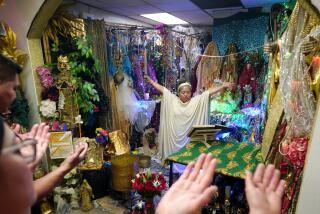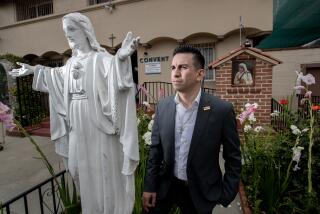Catholics confront changes to Mass
- Share via
The word “consubstantial” does not roll naturally off the modern American tongue. It’s one of those $5 words with Latin roots that tend to make the speaker sound pretentious or, if he trips over it, like a pretentious idiot.
Come Sunday, though, consubstantial will become part of the lexicon, at least for the tens of millions of Americans who worship in the Roman Catholic Church. For the first time since 1969, the Catholic Mass in the United States is undergoing significant change, rephrasing some of the best-known prayers in the English language.
Change doesn’t come easily, especially when it alters deeply ingrained rituals. Not all Catholics are happy with the new prayers, and some priests are deeply distressed by a translation that they find, in spots, to be tongue-twisting. But most seem willing to accept, even embrace, the new wording, which hews much more closely to the original Latin.
In instances when Catholics have said that Jesus “was born of the Virgin Mary,” they will now say he “was incarnate of the Virgin Mary.”
When they said, “I have sinned through my own fault,” they now will say, “I have greatly sinned,” and add the triplet: “Through my fault, through my fault, through my most grievous fault.”
And when they said in the Nicene Creed, the central statement of faith, that Jesus is “one in being with the Father,” they will now say that he was, yes, “consubstantial with the Father.” (Consubstantial, which comes from the Latin consubstantialis, means “having the same substance or essential nature.”)
“A lot of ink has been spilled” on that one word, said Msgr. Arthur Holquin, who is in charge of overseeing the transition to the new prayer book for the Diocese of Orange. “I would be less than honest if I didn’t say there are critics of this translation,” he added.
Such critics, Holquin said, argue that “when you are translating for a congregation that lives in the 21st century and speaks 21st century English, there is the perception and the judgment that this is regressive, because it appears that we are going back to an archaic language.”
The counter-argument, he said, is that the language of worship should be different -- higher, more formal -- than everyday speech.
The Catholic blogosphere has buzzed for two years with debate over the new translation. It has been called “clunky, clerical and academic,” “wordy, pompous and utterly unnecessary,” and “a great step backward.”
More than 22,000 people signed a petition on the website “What if We Just Said Wait?,” urging the church hierarchy to delay making the changes until they can be reevaluated and improved.
One Southern California priest, who asked not to be identified for fear of reprisals, said many question why time and money were expended on the new translation, given “all that the church has been through in recent years.”
“It’s not that I’m saying things that I don’t believe,” he said, “but underneath it all, I know a lot of my brother priests and myself wonder, shall we say, why all the muss and fuss?”
Still, the changes have many defenders. Julia Upton, provost of St. John’s University in New York and an expert on Catholic liturgy, said any grumbling is normal.
“Human beings are generally not thrilled about change,” she said. But she thinks the new liturgy will ultimately be an improvement.
“It’s both a gift and a challenge,” she said. “We get a lot of gifts in life that we don’t necessarily ask for, and we don’t always like them.... I think this is an opportunity for us to think a little more deeply about how we’re praying and what we’re saying.”
The new translation of the Latin prayer book, known as the Roman Missal, reflects a continuing reappraisal by church leaders of the Second Vatican Council, which transformed and modernized Catholicism in the 1960s.
Vatican II led to the first substantial change in the missal since 1570. Church officials now say they believe the English translation of that prayer book was hastily conceived and fundamentally flawed.
Its mistake, they say, was focusing on the creation of a readable English text at the expense of accuracy. The new missal is intended to translate the Latin as accurately as possible.
“We aren’t trying to go back; we’re just trying to update what we had and improve it as much as we can,” said Archbishop Jose Gomez of Los Angeles. “I see it as something positive.”
Father Daniel Merz, associate director of the Secretariat for Divine Worship at the U.S. Conference of Catholic Bishops, said the previous translation put more of an “activist” spin on the liturgy, in a way that made man, not God, the central player.
Now, he said, “I think we’ve kind of looked back and said, if we put too much emphasis on ourselves, the bottom tends to fall out. The idea is that we need to remember that anything that needs to succeed really needs to rely on God.”
Merz is leading an educational effort to explain the new liturgy to the American church. The same translation is being phased in throughout the English-speaking world, and will provide a template for translations into many other languages. “It’ll be bumpy for a while, but we’ll settle into it,” Merz said.
There were few noticeable bumps last Sunday at St. Euphrasia Church in Granada Hills. The pastor, Msgr. James Gehl, has been introducing the new liturgy in recent weeks, using his homily to explain the reasoning and giving his congregation an opportunity to practice the unfamiliar prayers.
“I’m just so used to the old one,” said Dennis Scheer, 53, who is barely old enough to remember the relief he felt when the current liturgy replaced one that was entirely in Latin.
Although the change isn’t easy, he said, “I guess if that’s the way they’re going to go, I’m fine with it. We’re just going to have to give it a little more thought, which is not a bad thing.”
Ben Pedrick, 83, who has been attending St. Euphrasia since its first Sunday, in May 1963, said the change is modest compared to the last one. “This is just a few words here and there,” he said.
During the service, Gehl switched back and forth between the two translations, giving the congregation a chance to practice the new prayers while saying goodbye to some of the old ones.
At one point during Mass, he recited the familiar Sign of Peace: “The peace of the Lord be with each of you always.” The congregation recited, as it has countless times before, “And also with you.”
That is a loose translation of the Latin, “ Et cum spiritu tuo.” The new translation aims to be truer: “And with your spirit.”
And so, at the end of the Mass, Gehl intoned, “The Lord be with you,” and the congregation responded: “And with your spirit.” No groans, no flubs.
Gehl smiled, looking out over nearly full pews. “That was pretty good,” he said.
--
mitchell.landsberg@latimes.com


